I agree Our site saves small pieces of text information (cookies) on your device in order to deliver better content and for statistical purposes. You can disable the usage of cookies by changing the settings of your browser. By browsing our website without changing the browser settings you grant us permission to store that information on your device.
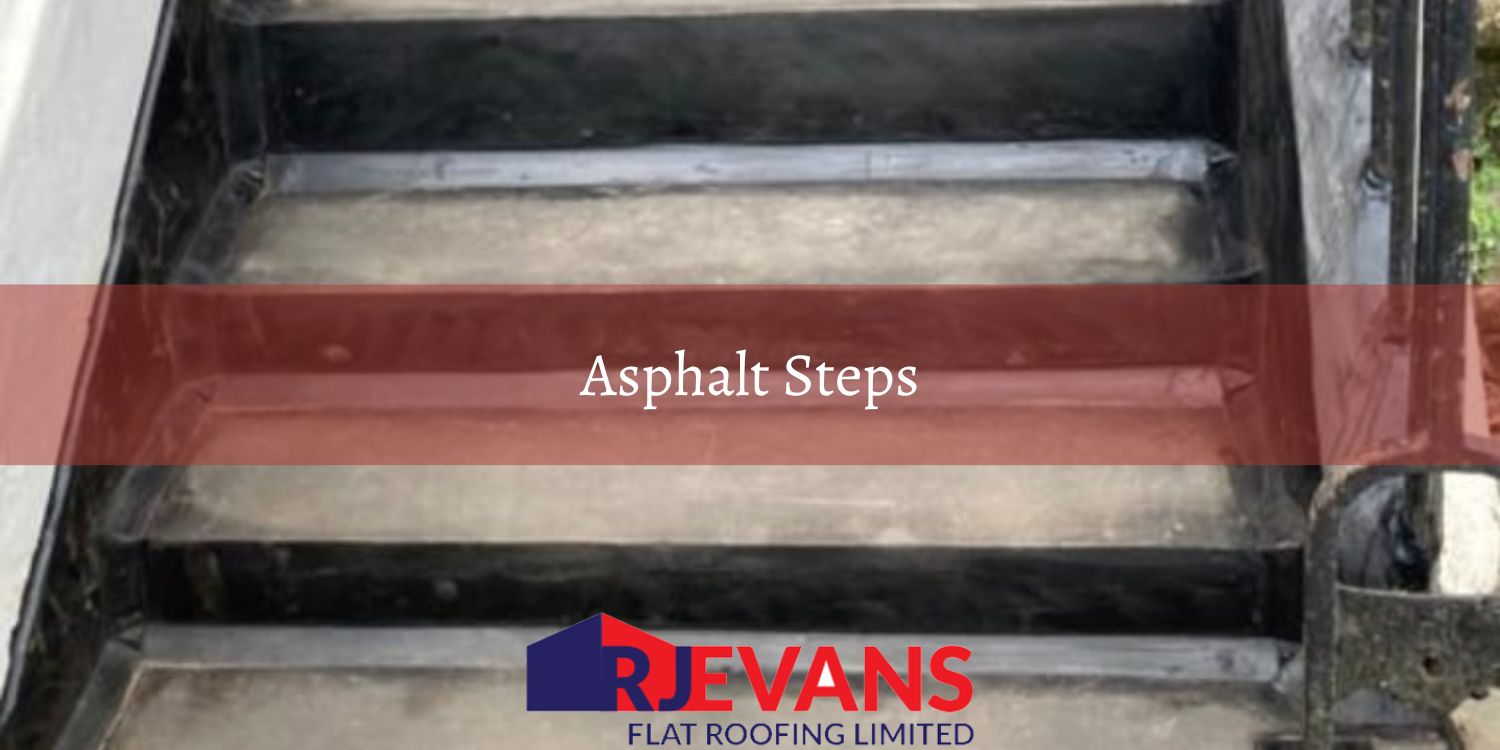
Asphalt steps refer to a construction technique where mastic asphalt, a highly durable, waterproof material, is used to waterproof steps or staircases in both residential and commercial buildings. Mastic asphalt is a mixture of asphalt cement, mineral aggregates, and fine sand. It is heated when in block form to create a dense, homogeneous, and easily workable solution. When applied to the substrate of step structures, it forms a seamless, resilient, and non-slip surface. Mastic asphalt waterproofing can withstand heavy foot traffic and harsh weather conditions. Asphalt steps are a popular waterproofing material due to their durability, longevity, and resistance to water penetration. Steps waterproofed with asphalt can be seen in various construction projects especially in famous cities such as London and Paris.
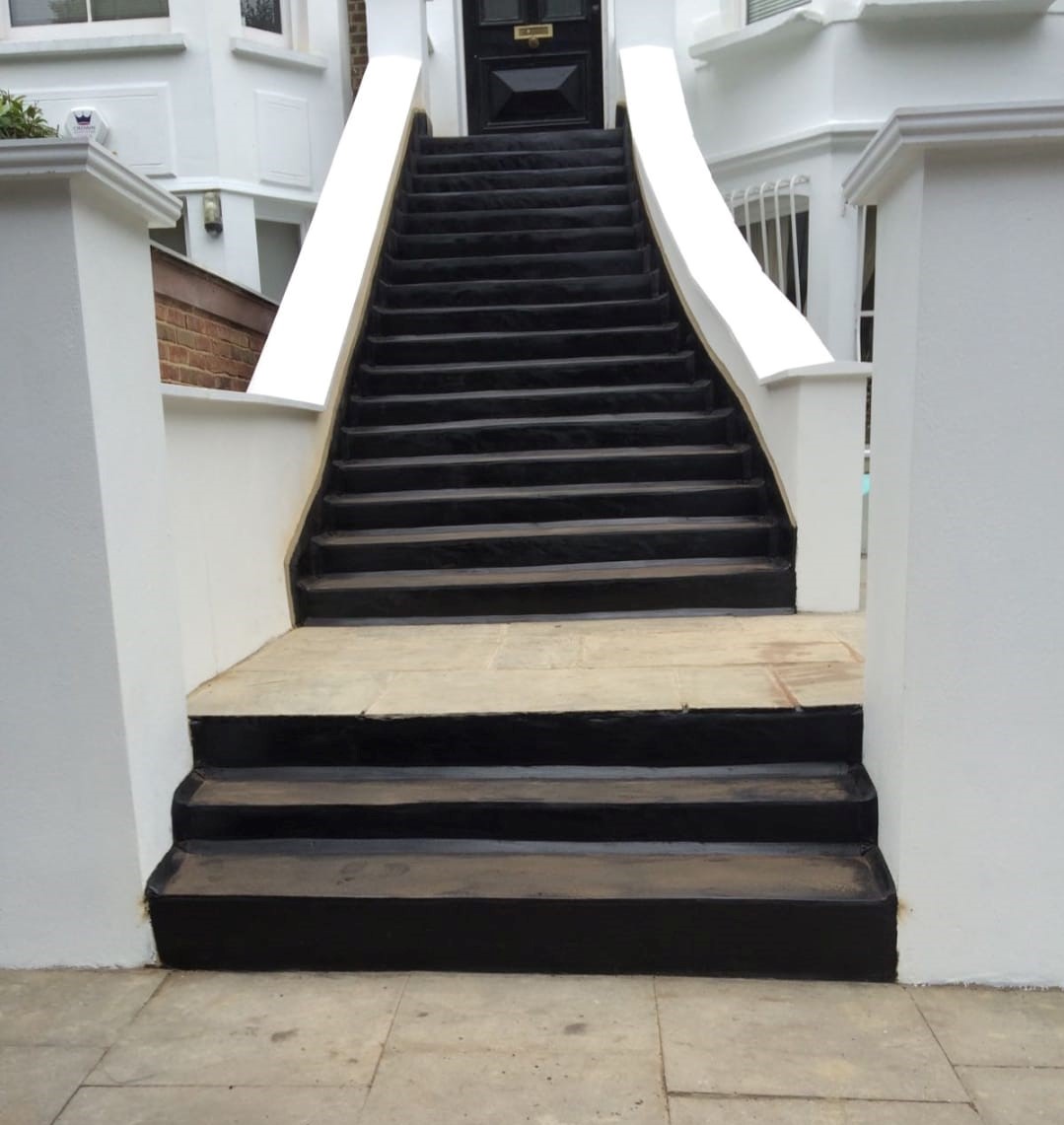
Mastic asphalt steps are a specialised form of waterproofing. They utilise mastic asphalt which is a highly durable and waterproof material. This is use to encapsulate staircases to protect the substrate from water ingress and is most often used for outdoor steps. Unlike conventional asphalt, mastic asphalt comprises finely graded aggregates bound together with a bitumen binder, which gives it superior flexibility, waterproofing capabilities, and a smoother finish. These steps are known for their exceptional longevity and resistance to water penetration, making them ideal for areas exposed to the elements. The installation process involves laying mastic asphalt over a prepared base, allowing it to mould precisely to the desired shape and dimensions of the steps, ensuring a perfect fit and a seamless finish.
The inherent flexibility of mastic asphalt prevents cracking under temperature changes or physical stress, thereby maintaining its integrity over time. Additionally, mastic asphalt steps can be finished with various textures or embedded with aggregates to improve slip resistance, enhancing safety in wet conditions. Given their robust construction, aesthetic versatility, and minimal maintenance requirements, mastic asphalt steps offer a practical and attractive solution for both residential and commercial properties seeking reliable and long-lasting outdoor staircases.
Mastic asphalt offers a multitude of benefits as a waterproofing solution for steps and other structural elements, standing out for its exceptional durability, environmental sustainability, and aesthetic flexibility. Its unique properties enable seamless and flame-free installations, providing a waterproof barrier that is both flexible and crack-resistant. Beyond its practical applications, mastic asphalt promotes safety through anti-slip surfaces and requires minimal maintenance, all while supporting eco-friendly construction practices with its recyclable materials and carbon zero status. This comprehensive overview highlights the key advantages of choosing mastic asphalt for waterproofing needs, demonstrating its superiority in both performance and environmental consciousness.
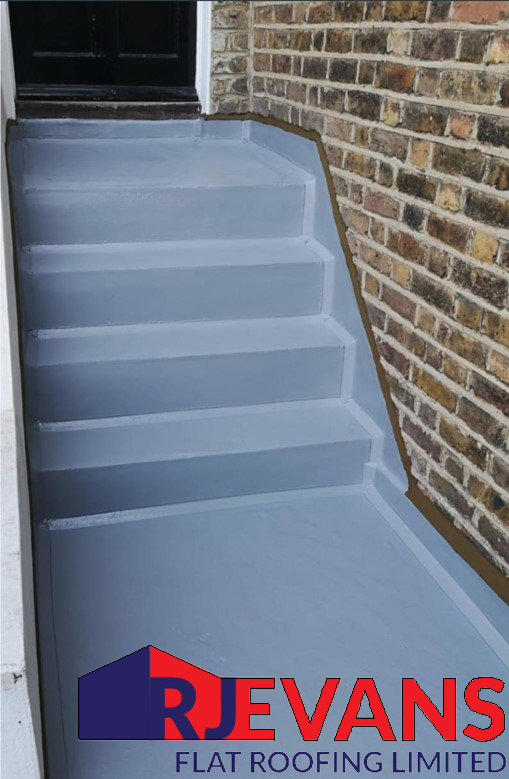
Mastic asphalt's longevity, often exceeding 30 years, is attributed to its robust composition, making it one of the most reliable waterproofing materials available. It thrives under the assault of extreme weather, from scorching sun to freezing temperatures, without losing its protective qualities. This resilience is critical for applications where long-term exposure to the elements is a concern, ensuring that the waterproofing performance remains consistent and effective throughout the decades, thus providing a secure investment in building protection.
The seamless, joint-free application of mastic asphalt creates an impervious waterproof barrier that is superior to other systems with potential weak points. This continuous layer effectively eliminates pathways for water ingress, ensuring comprehensive coverage. Such an installation is invaluable in creating roofs and surfaces that require complete waterproof integrity, preventing leaks that can lead to structural damage over time.
Mastic asphalt's adaptability to environmental and structural changes without cracking is a testament to its flexibility. This characteristic is particularly advantageous in climates with significant temperature variations, where materials are prone to expand and contract. Mastic asphalt's ability to maintain its form and function under such conditions significantly enhances its longevity and waterproofing efficacy, preventing water from compromising the protected structure.
Mastic asphalt not only excels in performance but also in its environmental impact, being fully recyclable and carrying a carbon zero rating. This demonstrates a commitment to sustainable building practices, allowing for the material to be reused or recycled at the end of its life cycle, thereby contributing to a reduction in construction waste and promoting a greener construction industry.
The utilisation of an asphalt mixer for mastic asphalt's application ensures a flame-free installation process, markedly increasing safety on the construction site. This method significantly reduces the risk of fires, making it a safer choice for both the workers and the immediate environment. This safety feature is especially critical in urban areas or in close proximity to sensitive structures.
Mastic asphalt's exceptional malleability makes it the material of choice for waterproofing complex architectural features. It can be precisely moulded to fit unique shapes and angles, offering effective waterproofing solutions for areas that are typically challenging to protect. This adaptability ensures that every nook and cranny is covered, leaving no area vulnerable to water damage.
The potential to enhance mastic asphalt with aggregates for added slip resistance is crucial for ensuring safety in pedestrian areas. This feature is particularly important in wet or icy conditions, where the risk of slips and falls is increased. Such preventative measures are essential in public spaces, steps, and walkways, making mastic asphalt a responsible choice for communal safety.
Mastic asphalt's straightforward maintenance and repair process ensures that any potential damage can be quickly and efficiently remedied, keeping the surface in pristine condition with minimal downtime. This ease of care is instrumental in prolonging the lifespan of the waterproofing system and maintaining its aesthetic appeal without incurring significant costs.
The ability to customise mastic asphalt in terms of texture and colour offers architects and builders creative freedom to match or enhance the design aesthetics of a project. This flexibility allows mastic asphalt to seamlessly integrate with any architectural style, providing both functionality and visual appeal in a single solution.
The application of a solar protective coating not only improves the visual finish of mastic asphalt surfaces but also plays a vital role in reducing heat absorption. This feature is crucial for maintaining cooler surface temperatures, thereby extending the material's durability by protecting it against the harsh effects of continuous UV exposure and the thermal expansion and contraction cycle.
The first thing which needs to be done before waterproofing steps in mastic asphalt it to ensure that the substrate is actually suitable for asphalt to be applied.
Things to consider before using Mastic Asphalt to Waterproofing your Steps:
Is the staircase to be waterproofed structurally sound?
Are there any hazards in the proximity which could damage the asphalt once it is laid? One such hazard to asphalt is oil.
Is the surface a material which mastic asphalt and the primer can adhere to? Surfaces suitable for asphalt steps include concrete and tiles.
Is the surface showing any signs of damp? If this is the case the substrate will need to be dried out before any work is carried out. This is to make sure there is no moisture trapped underneath the asphalt once the asphalt waterproof coating is applied.
If there is an existing waterproofing coating on the steps, this will have to be removed. Obviously if this is not the case this step is not necessary.
If there is a liquid system currently coating the steps it will need to be removed. To do this the liquid coating will have to be removed with an abrasive. Then the steps will need scrubbed down and sand blasted to complete the removal.
Old asphalt will need to be removed with a hammer and bolster. This will need to be carried out extremely carefully by an asphalt specialist. The reason for this is to avoid any damage happing to the substrate. Any remaining asphalt on the substrate will be removed with an abrasive, scrubbed down and sandblasted to finish the remove of the mastic asphalt.
Once this has been done there will be a lot of debris from the old asphalt. At RJ Evans, we take great pride in being an environmentally friendly company so all of this debris will be taken in rubble bags taken to our asphalt mixer and recycled to be used as a mastic asphalt screed.
Next the substrate needs to be inspected to ensure the surface is flat and the asphalt has something to bond too. If this is not the case the defects need to be remedied with rendering or concrete being poured.
If repairs to the substrate need to take place it is imperative to ensure everything is completely dry and dust free before priming.
The required chase size for asphalt steps is 25 x 25mm. This allows the asphalt to sit into the chase line and be ready for finishing with sand and cement mortar. The chase line is cut with an angle grinder.
Once it is certain the substrate is completely dry and dust free it is time to apply the primer.
The substrate needs to be primed with a high-bond primer. The reason for this is if you use a bitumen primer2, the heat in the summer months will cause the oil to rise to the surface and create one of the common problems seen in asphalt steps, blows. Once applied the primer will take 1-2 hours to dry out (this can be made faster by carefully applying a gas torch to the primer).
Sheath felt is applied to the treads of the steps. This is used a separating membrane. It is loose laid with a bitumen content which adheres to the mastic asphalt. But this sheathing felt will allow movement between the substrate and the finished asphalt steps.
The first base waterproofing layer for asphalt steps is mastic asphalt 988T3. This is roofing grade mastic asphalt which as the name suggests is commonly used in asphalt roofing4. Recreational duty asphalt can also be used instead of roofing grade asphalt. The main benefit of RD asphalt is it takes away the need to apply solar reflective paint on the finished steps.
First this initial coating of asphalt is applied to the side stringers up to a thickness of between 7 and 8 mm. This is applied with a wooden float (interestingly these are handmade). This coating to the stringers is tucked into the prepared chases for termination.
Next the risers will receive their first coat of mastic asphalt. This is also in roofing grade mastic asphalt and is applied with a wooden float.
Now it is time to apply the top coat of mastic asphalt to each of the treads on the steps we are waterproofing.
The top coat for the treads on the step is laid with recreational duty asphalt1 which has 3mm grit added. This 3mm grit is about 10-15% of the mix. The reason for the use of paving grade asphalt is to provide the extra durability required to cope with foot traffic a set of steps endures.
A batten is fit to 15mm above the riser in each tread to mark out the height which the asphalt needs to be applied up to. Then the asphalt is laid out of the bucker up to the height which has been marked with the batten. Just like earlier this coat of mastic asphalt is applied with a wooden float.
Next coarse sand is thrown over the asphalt tread which has been laid. And this is rubbed into the mastic asphalt coating. The reason for this is that if it is not done when it rains the bitumen content of the asphalt will rise to the surface when it rains. This rubbing of sand is done once the whole of the tread is covered and the result is a coarse level finish.
Now the team installing the asphalt steps will brush away all of the excess sand from the area and remove the battens which were fitted to ensure the coat was laid to the correct height of 15mm.
The upstands on any mastic asphalt staircase must be at least 150mm high and go into the chase and be finished by pointing with sand and cement mortar. The top coat thickness of these asphalt upstands should be 7-8mm thick. Just like with the asphalt treads coarse sand will be rubbed into this top coat of mastic asphalt to prevent the bitumen rising.
The asphalt specialist will now apply a 7-8mm top coat of mastic asphalt to each of the risers on the staircase. When this coat is being applied the coat of asphalt on the risers is allowed to slump over the tread. This is called the poultice method where the asphalt is placed on the top to apply and make a clean joint. The risers coat of asphalt is married in with the treads coat of asphalt and we apply a double filler seal. This allows us to create a seamless finish. As always, once the top coat is applied to the risers they are sand rubbed with a wooden float to prevent the bitumen rising.
To complete the waterproofing of asphalt steps the vertical elements have to be joined to the horizontal earlier. As mentioned earlier the vertical of the risers asphalt was married to the horizontal of the treads with a double angle fillet.
To bond and fully waterproof the steps the same must be done between both the treads and risers with the upstands running along the strings of the stair case. The use of angle fillets doesn’t just successful leads to the complete waterproofing of the asphalt steps. It also is the most decorative part of the staircase. The beautiful detailing leave the asphalt steps as a piece of working which is extremely pleasing on the eye.
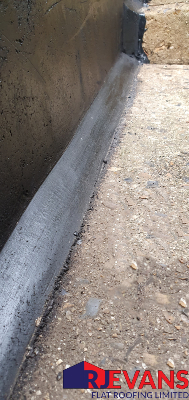
It is not uncommon to see asphalt steps accompanied by a handrail. When it comes to waterproofing steps which contain a handrail, the finishing is extremely important. The options here are either to finish the steps with fillets or to use asphalt collars. The chosen option will largely depend on the agreed specification.
The application of a mastic asphalt collar involves tanking the mastic asphalt up to approximately 100mm. 2 coats of mastic asphalt are applied with an angle fillet to the asphalt base.
The collar needs to be finished with mastic to keep the handrails connection to the base waterproofed full out the year. This is due to the movement which happens as the temperature changes and pulls the handrail away from the asphalt. If a mastic is not applied there is a risk of water ingress.
Another common place where you can see an asphalt collar used when waterproofing steps in around a soil vent pipe.
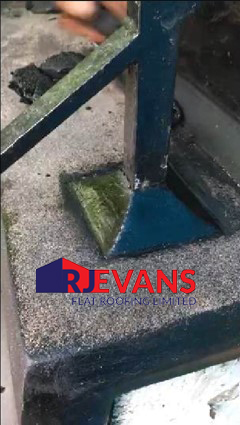
On other occasions asphalt fillets will be used to finish a handrail on an asphalt staircase. This will be done in exactly the same way as mentioned above with the connection of the horizontal of the asphalt to the vertical. Once completed the angle fillet leaves an extremely attractive decorative finish.
There are two ways to waterproof the chase on a set of asphalt steps. These ways are sand and cement mortar or mastic.
A sand and cement mortar chase is best to use when the chase is cut into brick. And the mastic chase is best to use on concrete. One benefit of the use of mastic is you are able to select a colour to blend in with the rest of the asphalt stair case.
Maintaining the sealant of the chase is a very important part of ensuring your asphalt steps benefits from the longest service life possible.
Once a set of steps are complete you can add solar reflective paint2 if roofing grade rather than recreational grade asphalt is used for your steps this can help ensure they last for the longest time possible. The reason for this is because in the summer months the sun heats the roofing grade asphalt and if there is prolonged exposure this can cause slumping. Additionally, the sun can draw the bitumen out of the asphalt leaving it looking grey and worn.
Although this solar reflective paint does not completely prevent the effects of the sun upon the asphalt. It can greatly diminish the effect it has.
If this option is chosen for a new set of asphalt steps 2 coats of solar protective paint will need to be applied. This solar reflective paint is applied to the treads, risers and stringers. The finish of these solar protective paint is a pleasing on the eye light grey colour.
One downside of solar reflective paint is it reduce friction on the surface of the steps and can potentially lead to slipping.
It is an important part of maintenance to re-apply the solar reflective paint every 5 to 7 years if you want to get the most lifespan out of your steps.
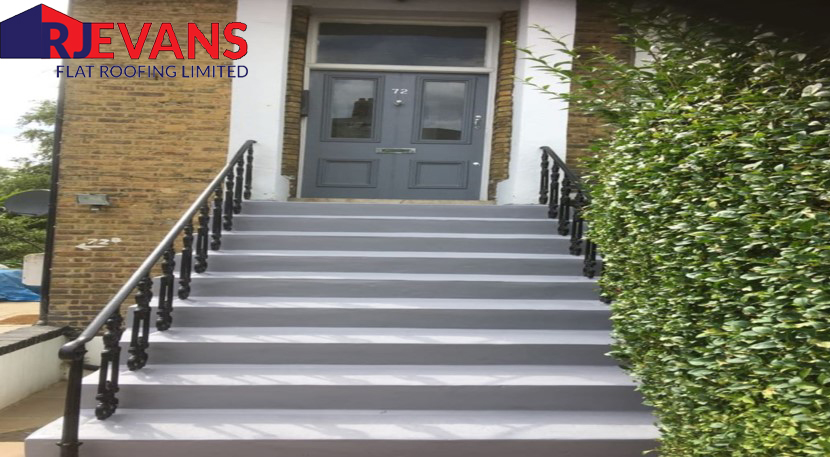
Once a set of asphalt steps has been installed it is important to care for them in order to get the maximum from them. Some of the things to do to maintain your steps have been mentioned above such as re-applying solar reflective paint every 5 to 7 years and ensuring the chase lines are sealed correctly.
Other areas to look out for are:
• Is movement having any effect on the asphalt waterproofing system?
• Are any adverse chemicals such as oil getting to your steps?
• Are there any signs of water ingress?
• Is moss growing around the base of your handrails?
• Are there any stress cracks (this can happen from heavy objects being dropped?
• Are there any blows in the asphalt?
• Has any slumping occurred?
You can find out more about common problems with asphalt steps by clicking the following link:
https://www.rjevansroofing.com/blog/common-problems-with-asphalt-steps/
The good news is asphalt is one of the only construction materials which can be completely repaired, so if you do have any maintenance needs they can be remedied cost effectively.
Better than waiting for problems to occur is to schedule a regular maintenance check for your asphalt steps rather than take the risk of waterproofing system failing and causing damage to the valuables below your steps.
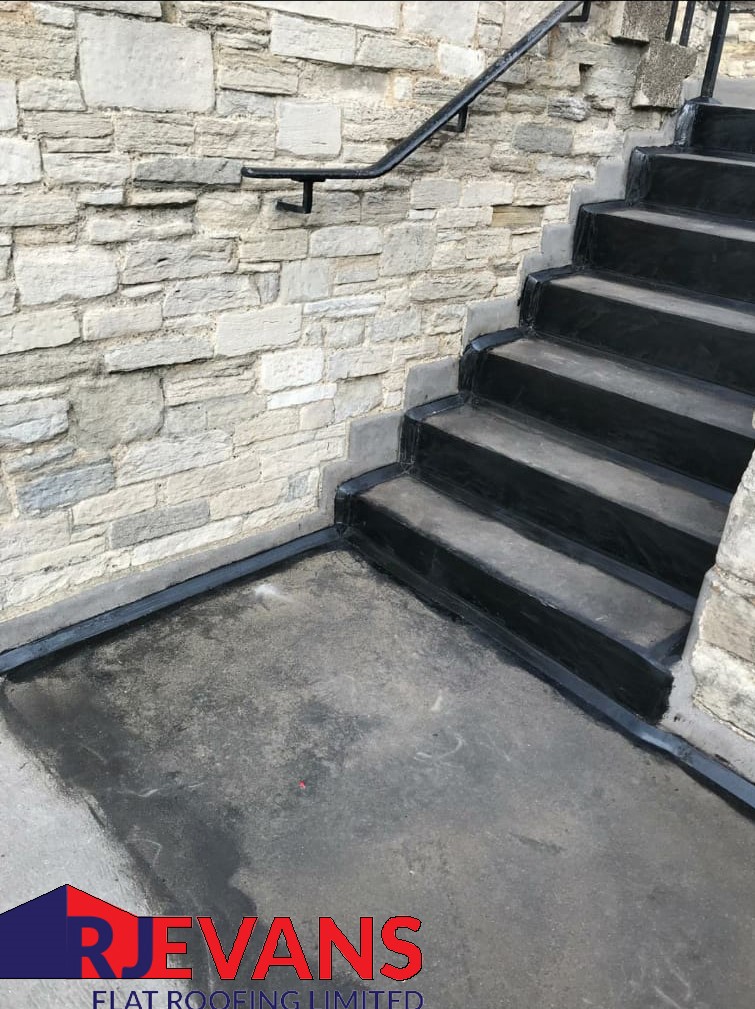
We carried out repairs on asphalt steps which had endured heavy foot traffic over the years. Unsurprisingly given the amount of visitors this attraction receives every year the steps were rather worn. You may notice we left this steps without solar reflective paint. The reason for this was so once worn in the steps would match the other asphalt staircase at the 'Tower of London'.
We are a specialist in asphalt steps covering everything from asphalt repairs to the complete waterproofing of steps. We have a team of asphalt experts which consists of members who have more than 40 years’ experience working with asphalt steps.
RJ Evans cover the whole of London for both Asphalt Steps and Asphalt Step Repairs. The areas we work in include Islington, Kensington, Ladbroke Grove, Chiswick and Hackney.
Whether you have noticed your asphalt steps are starting to look worn and in need or rejuvenation, have problems with leaking or need a set of steps waterproofed we can help you. We will provide you with free impartial advice and advise you on the possible solutions to your specific situation.
If you would like a quotation or any information on Asphalt Steps please contact us or call us on 01277 375 511.
• We have our own Asphalt Mixer this means a flame free laying of the mastic asphalt. Better consistency in the asphalt mixture meaning a more efficient installation process with a better overall finish.
• Vastly experienced asphalt team. We have operatives with more than 40 years’ experience.
• We provide a range of FREE quotations and solutions for all projects.
• Insurance backed Guarantees.
• Excellent Customer Support from R J Evans throughout your project.
• Rated 5 out of 5 from our previous customers.
If you would like a quotation or any information on Asphalt Steps please get in touch with us or call us now on 01277 375 511.
.